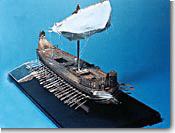


  |
|
|
Polycrates was of noble descent and governed Samos as a tyrant, from ca. 538 until
 |
The construction of Samos' harbour and of the ditch around the city's wall date from his time, as well as the effort to reconstruct the Heraion, the famous temple originally designed by Rhoecus and Theodorus and completed in the Hellenistic and the Roman times (Herodotus, Historia 3.60). In his time a new type of ship was designed, the so-called Samaina. It was a dieres with an obtuse prow, which functioned both as a trader and as a warship (Athenaeus, Deipnosophistae 540d-e). |
|
| |
|
Note: Click on a picture for a brief description. | |